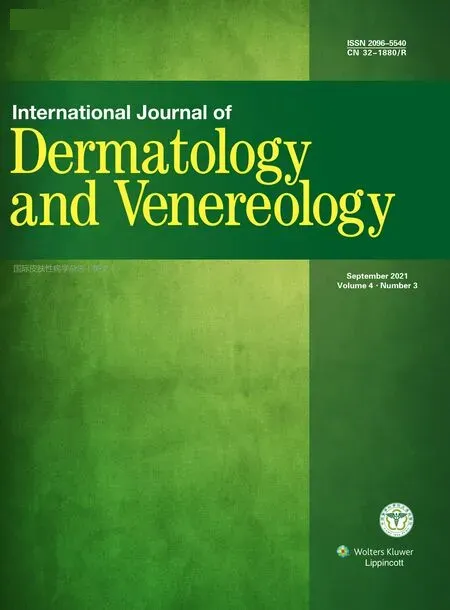Ablative Carbon Dioxide Laser Treatment for Papular Scars of Nose and Chin Due to Acne:A Case Series
Sanjeewani Fonseka?,Dasun Chathumina Wickramaarachchi,Dilan Dileepa Jayarathne Bandara
Department of Pharmacology,Faculty of Medicine,University of Peradeniya,Peradeniya20400,Sri Lanka.
Abstract
Keywords:acne scar,papular Scar,ablative carbon dioxide laser
Introduction
Acne leaves scars in95%of patients,especially if the acne is inflammatory or treatment is delayed.1Various treatments are available,such as laser therapy,light treatment,subcision,chemical peeling,dermal fillers,platelet-rich plasma,debulking procedures,and microneedling.2
Acne-induced papular scarring of the nose and chin is an under-recognized variant that was first described in 1990.3-4Several treatment options have been proposed,but none seems to be successful.
We herein report a series of patients with papular scars of the nose and chin treated with ablative carbon dioxide laser therapy with a considerably high success rate.
Case report
Five patients with papular scars of the nose and chin due to acne were treated at an outpatient dermatology clinic.All had type V skin according to the Fitzpatrick skin classification.Ablative carbon dioxide laser therapy(10,600nm,continuous mode,energy of15W)was performed under topical anesthesia.Infiltration of a local anesthetic agent(1% lidocaine without adrenaline)was used to achieve anesthesia.Topical emollients and sunscreen were applied until the lesions healed.The patients were re-examined at2-to3-week intervals,and laser treatment was repeated as needed.The progress of the lesions was monitored by digital photography.
The five patients(three women,two men)ranged in age from22to36years.One patient was treated for papular scars of the chin,and all others were treated for papular scars of the nose(Fig.1A,C,and E).The change in the size of the popular scars was measured to assess the results of the laser therapy.Digital photographs were used to take measurements.Table1summarizes these results.At the end of the first treatment,the patients showed about50%improvement in the scars(Fig.1B).However,two patients who underwent four treatment sessions showed80%improvement(Fig.1D and1F).

Figure1.Pretreatment(A,C,and E)and post-treatment(B,D,and F)photographs of patients with papular scars of the nose after one session of ablative carbon dioxide laser therapy.
None of the patients developed post-laser hyperpigmentation,hypopigmentation,or infection.However,disadvantages of the treatment were mild to moderate pain during the procedure and the need for post-treatment skin care.All lesions were re-epithelialized by about14days after the procedure.During follow-up,no patients developed relapse of the condition or adverse events.All of the patients provided written informed consent.
Discussion
Papular scars of the nose and chin are the most difficult acne scars to treat because of the destruction of collagen and elastic tissues around the hair follicle.The lesions comprise multiple non-scaling,skin-colored,soft fibrous papules that are typically distributed over the nose and chin.They have a cobblestone appearance and become flatter during facial expressions such as smiling,differentiating them from hypertrophic scars.5
Of the five patients in this study,four had lesions over the nose and one had lesions over the chin.After a single treatment,three patients showed about50%improvement in their scars.Two patients showed about80% improvement after four treatment sessions.The lesions were ablated until they completely disappeared.After laser treatment,the lesions healed with buildup of some scar tissue,but not to the original severity.This might have been prevented if the ablation had been performed below the skin surface.
Injection of local anesthetic agents to the site also partly obscured the lesions.Before the ablations,the lesions were marked with a skin marker to prevent this complication.However,tissue swelling likely obscured the true size of the lesion.
Accurate objective assessment of the lesions was difficult because they were tiny and not on a uniform surface.Even in a photograph,the curvatures of the nose and chin change the true appearance of the scars,and this is a limitation of the present study.Importantly,the patients’satisfaction was high and no adverse events were noted.
Papular scarring of the nose and chin is under-reported,probably not because of its rarity but instead because of inadequate attention paid by clinicians.A study in the United Kingdom showed that4% of149patients attending a tertiary dermatology clinic had papular scars over the chin and nose.The study also showed malepredominance and an association with other types of acne scaring.4Histological examination of the lesions showed fibrous scarring with a few ectatic blood vessels and mild chronic inflammation.4

Table1 Treatment effects of ablative carbon dioxide laser for papular scars of nose and chin due to acne.
Two studies have been performed to evaluate the treatment options for these difficult-to-treat scars.One report described a technique in which radiofrequency energy was delivered directly to the lesions through a hypodermic needle,and good results were attained.The authors claimed that this technique minimizes the postinflammatory hyperpigmentation/hypopigmentation and scarring associated with superficial ablation.6
Another study showed successful treatment of papular scarsusinganerbium:yttrium-aluminum-garnetlaserbythe pinhole method,which involves the creation of multiple tiny holes that penetrate from the epidermis into the deeper dermis.Two patients were treated with good aesthetic results.7This method is likely to be effective because2940-nm erbium:yttrium-aluminum-garnet lasers target watercontaining tissues more than other types of lasers.
Because of the profound psychological impact of acne and acne scars,it is very important to treat the scars effectively.8The currently available evidence to guide treatment is in the preliminary stage,necessitating the performance of well-designed studies and exploration of newer techniques to treat this challenging condition.
- 國(guó)際皮膚性病學(xué)雜志的其它文章
- Mask on Followed by Gloves on:Do We Have a Choice?
- Mobilization of Melanocytes During NB-UVB Treatment of Vitiligo
- Consensus on the Diagnosis and Treatment of Melasma in China(2021Version)#
- Retiform Hemangioendothelioma
- Malignant Syphilis as an Initial Presentation of HIV Infection:A Case Report
- Treatment of Nevoid Basal Cell Carcinoma Syndrome by Surgery Combined With ALA-PDT:A Case Report

